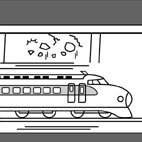| Case Name |
Concrete flaking in a Shinkansen tunnel of West Japan Railway Co.. |
| Pictograph |

|
| Date |
June 27, 1999 |
| Place |
Fukuoka Prefecture. |
| Location |
Fukuoka tunnel, Kitakyushu tunnel between Kokura and Hakata. |
| Overview |
Concrete in the Fukuoka tunnel between Kokura and Hakata in JR Sanyo Shinkansen line flaked off. The flake directly hit a Hikari Shinkansen train running in the tunnel, and the roof of rolling stock and part of the pantograph were damaged. Because of this accident, West Japan Railway Co. checked all tunnels of Sanyo Shinkansen line and made the safety announcement. But after about 3 months, it was found that concrete mass had fallen on the line of the Kitakyushu tunnel in the same section. |
| Incident |
The concrete mass flaking matter in the tunnel caused a lowering of the reliability for the concrete structure of Sanyo Shinkansen line together with the concrete piece falling matter from viaduct, which was reported much after 1996. |
| Sequence |
On June 27th, 1999, the concrete mass in the Fukuoka tunnel between Kokura and Hakata in JR Sanyo Shinkansen line directly hit the Hikari Shinkansen train running in the tunnel, and the roof of rolling stock and part of the pantograph were damaged. Luckily, no one was injured, but suspension and delay of trains of this section arose one after another because of the power cut. About 4 hours were taken to restart. On October 9th of the same year, it was found that the concrete mass had fallen on the line of the Kitakyushu tunnel in the same section. West Japan Railway Co. canceled the operation of the Shin-Osaka-Hakata section, and this had an influence on about 62000 persons including holidaymakers on the first day of 3 straight holidays. |
| Cause |
The cause of the accident of the Fukuoka tunnel was the inconsecutive plane of the concrete, which is called cold joint (CJ). Throughout construction, curing, and use, the crack was generated in the inside of the CJ, and it developed, and it seemed to cause the flaking. In the case of the accident of the Kitakyushu tunnel, a protuberant pouring mouth established by the construction process was not removed after completion of the tunnel, and was left as it was. For some reasons such as subsidence of the side wall, the crack between the projection and the side wall occurred. Then, the crack developed by water leak, temperature change, train vibrations, etc. in the long term, and it finally fell because of the dead weight. |
| Response |
Because of the accident on June 27th, West Japan Railway Co. checked CJ of all 142 tunnels of Sanyo Shinkansen line by hammering test. And it carried out temporary measures such as the removal of the bad part by hitting. Because of the flaking accident after about 3 months, when another concrete flaking happened by the cause except for CJ, West Japan Railway Co. "assumed all situations" for prevention of recurrence of the accident, and from October 25th, carried out the bigger inspection than ever with its deadline on December 15th to all 142 tunnels. |
| Countermeasures |
While West Japan Railway Co. has carried out review of inspection periods, inspection methods, criteria, and repair method of tunnel, viaduct and the like, it has advanced introductions of the accreditation system in the repair work and positive introductions of the new technology development result, etc., and it has tackled improvement of the maintenance management system. |
| Knowledge Comment |
Understanding and technical measures of the property of concrete, arrangement and field education of the methodology on concrete construction and the maintenance, improvement of the consciousness of safety management in manager, consideration of the maintenance cost in design stage. |
| Background |
The background was the rushed work, execution defects because of it, the use of sea sand because of material shortage, and the early deterioration of concrete developed into the social problem from the 1980's. |
| Incidental Discussion |
In the television image after the accident-generation, the work situation in which the inspector who looked up and opened his mouth in hammering test of the concrete wall in the tunnel by hammer was broadcasted many times, and the society's trust for the civil engineering technology lowered. As a result, this case can be said to be one of the motives for the move towards the automatic measurement by the mechanization. |
| Reason for Adding to DB |
As a part of Shinkansen train technology which Japan prided herself in the world, the interest of the nation was attracted. |
| Scenario |
| Primary Scenario
|
Poor Value Perception, Poor Safety Awareness, Carelessness, Insufficient Precaution, Usage, Maintenance/Repair, Damage to Society, Social Systems Failure, Loss to Organization, Social Loss, Loss to Organization, Social Loss
|
|
| Sources |
Koei forum No.9th/2001.1.
"Concrete in danger" by KOBAYASHI Kazusuke, Iwanami Shinsho.
"Concrete technology" by KOBAYASHI Kazusuke, Morikita Shuppan.
Chugoku newspaper. Nikkei construction. Nihon Keizai newspaper.
West Japan Railway Co.
ReNEWAL NEWS
|
| Number of Deaths |
0 |
| Number of Injuries |
0 |
| Physical Damage |
flaking of the wall in the tunnel, damage of Shinkansen train. |
| Consequences |
The question mark was raised about the safe myth of Shinkansen, and the interest of the nation was hunted out. |
| Field |
Civil Engineering
|
| Author |
KUNISHIMA, Masahiko (The University of Tokyo)
ISHIHARA, Yukihiro (The University of Tokyo)
|
|